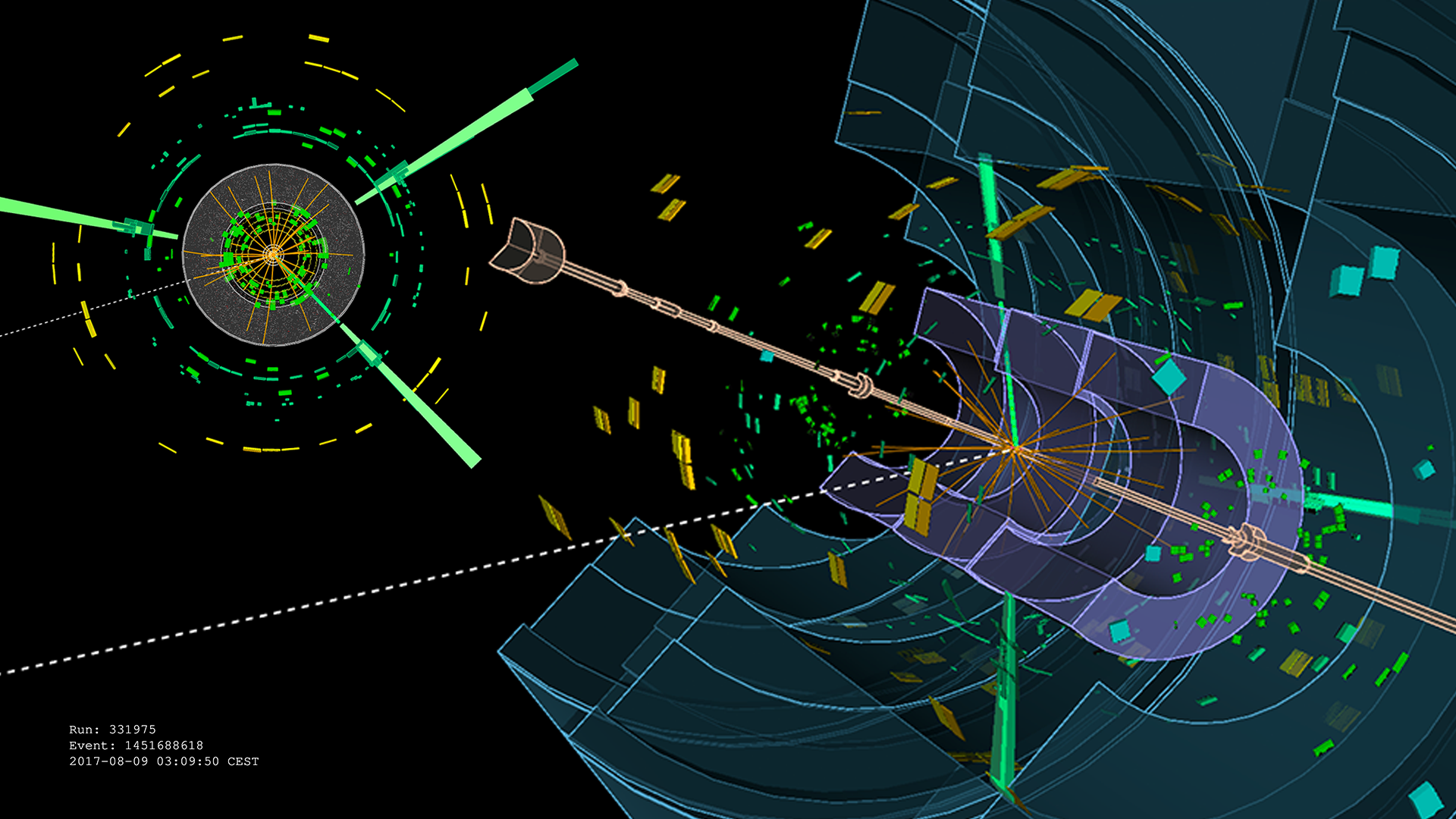Three’s no crowd: ATLAS measures tri-boson production
18 August 2023 | By
At the LHC, force-carrying particles can be produced by themselves, in pairs or even in trios. This is because the particles that carry the weak and electromagnetic forces – the W and Z bosons and the photon (γ) – are able to interact with each other directly. Indeed, the strengths of these interactions are predicted by the electroweak sector of the Standard Model, making their measurement an excellent test of the theory. Using the vast amount of data collected during Run 2 of the LHC (2015 to 2018) and new analysis techniques, the ATLAS Collaboration has reported three separate new measurements of tri-boson processes.
The ATLAS Collaboration has announced the first observation of two different tri-boson processes: the simultaneous production of a W boson with two photons (Wγγ) and the production of a W boson, Z boson and photon (WZγ). The production of a Z boson with two photons (Zγγ) was first observed in 2016 using data from LHC Run 1 (2010-2013). In a new publication, the ATLAS Collaboration expanded the scope of this initial observation using Run 2 data.
These processes are difficult to measure, as they are extremely rare and can be hard to disentangle from other physics processes that mimic their signatures in the detector. For these new analyses, physicists looked for “leptonic” decays of the W and Z bosons. Specifically, for Z bosons decaying to a pair of electrons or muons, and W bosons decaying to an electron or muon, accompanied by a neutrino. While electrons, muons and photons interact directly with the ATLAS detector and are well measured, neutrinos are invisible to the detector. They are reconstructed indirectly as missing transverse energy. So, for each process, events with various combinations of electrons, muons, photons and missing transverse energy were selected from the Run 2 dataset.
The ATLAS Collaboration has observed three different tri-boson processes: the production of a W boson with two photons (Wγγ), the production of a W boson, Z boson and photon (WZγ), and the production of a Z boson with two photons (Zγγ).

The ATLAS Collaboration observed the Wγγ process with a significance of 5.6 standard deviations, above the 5 standard deviation threshold required to claim observation. This corresponds to a less than 0.00003% chance that the measurement was due to a statistical fluctuation. This result benefited from the increased 13 TeV centre-of-mass energy (thereby increasing the cross section of the process), and improved data-driven techniques used to estimate several backgrounds from misidentified objects in the detector. These included backgrounds from events in which one or both of the recorded photons were actually misidentified hadronic jets (originating from quarks or gluons), or misidentified electrons. Researchers measured the cross section with a precision of 17%. Example event displays for the electron channel and muon channel decays are shown in the header and Figure 1, respectively.

The WZγ process was observed with a significance of 6.3 standard deviations, also well above the threshold to claim observation. Similar to the Wγγ analysis, the main challenges for this measurement were the data-driven estimates for the backgrounds from misidentified objects. The largest of these backgrounds is from hadronic jets being misidentified as either leptons or photons. Researchers also measured this cross section with a precision of 17%. An example event display for the muon channel is shown in Figure 2.
The Zγγ cross section was measured with a precision of 12%, making this the most precise measurement of this process to date. In their new analysis, physicists also measured the dependence of the cross-section on certain variables describing the Zγγ system – providing a more extensive test of Standard Model predictions. These measurements were used to constrain the magnitude of physics beyond the Standard Model that could arise through anomalous interactions between electroweak gauge bosons. The measured cross section for this process as a function of the transverse momentum of the two leptons from the Z boson is shown in Figure 3. Also shown in the figure is an example of a new physics contribution, if assumptions are made about the energy required to produce it. As good agreement was found between the data and prediction, physicists were able to confidently rule out such new physics effects at these energies.
The studies of tri-boson processes remain in an early stage but these recent results demonstrate the feasibility to do these kinds of measurements. The understanding of these processes is also crucial to measuring other physics processes – such as the production of W or Z boson alongside a Higgs boson which then decays to two photons – which will become evermore important in Run 3 of the LHC and beyond. With more data and higher energies, these processes will provide further insight into a relatively unexplored area of the Standard Model and could even reveal new physics beyond our current understanding.

Learn more
- Observation of Wγγ triboson production in proton-proton collisions at 13 TeV with the ATLAS detector (arXiv:2308.03041, see figures)
- Observation of WZγ production in proton-proton collisions at 13 TeV with the ATLAS detector (arXiv:2305.16994, see figures)
- Measurement of Zγγ production in proton-proton collisions at 13 TeV with the ATLAS detector (Eur. Phys. J. C 83 (2023) 539, arXiv:2211.14171, see figures)




